
   |
 |
|
|
|
|
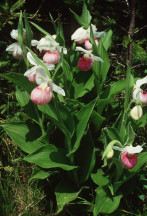 Showy Lady Slipper
Showy Lady Slipper
Description Cypripedium Reginae commonly known as the Showy Lady Slipper is one of the largest members of the genus. This rare terrestrial orchid is also aptly named the Queen's Lady's Slipper. As the plant matures, it typically forms multiple stems of 2 to 3 feet each with 1 to 3 flowers per stem. Leaves are lime green, monocot and hairy. White sepal and petals. Flower is white with a painted fuschia (deep pink) slipper. Staminode is yellow and white with red spotting. Blooms 7-14 days from mid-June to early July. Showy Indeed! It's a beauty and one of our favorites. It will be yours too!! USDA Growing Zones Recommended optimal USDA zones are 3 to 6. Plants may be grown in zone 2 with extra winter mulching protection and zone 7 if the ground is kept cool and moist with adequate shading. Soil/Media/Growing Requirements Requires a neutral pH soil/media. They require 2 to 3 hours direct early morning or late afternoon sun and be in dappled shade/sun the remainder of the day. Roots must always be moist and never allowed to dry out. They detail what we have found to work well for us with the Cypripedium Reginae and we have grown thousands! These plants are found in nature in open well drained but moist areas, along roadsides and in open fields, and in cultivation do well in open gardens with well-drained soil. Some protection from direct sun is beneficial in the warmer climates. This item has only a $6.50 Shipping & Handling Charge up to 25 plants ordered. This amount will be added to your order. These are 5th year transplants. They should flower within 1-2 years. plants will ship late April/Early May. |
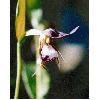 Cypripedium arietinum
Cypripedium arietinum
Ram's Head Lady Slipper North America H: 15-30 cm (6-12 in) 3rd year plants Z: 3-5 pH: 5-6 Blooming: End of May to June The smallest of the lady's slippers, this flower is striking for its pointy white pouch with red veins and white hairs, surrounded by a pair of brown sepals and petals, giving the impression of a ram's head. Light cherry fragrance. One of the rarest North American orchids. Cypripedium species normally bloom after their 5th or 6th year (cycle) of growth. Mature plants have already bloomed or are of blooming size. This item has only a $6.50 Shipping & Handling Charge up to 25 plants ordered. This amount will be added to your order. They should flower within 1-2 years. plants will ship late April/Early May. |
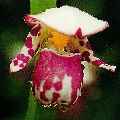 Cypripedium guttatum (x alaskanum)
Cypripedium guttatum (x alaskanum)
Alaska H: 10-38 cm (4-15.5 in) 3rd year plants Z: 2-4 Blooming: June-July A natural hybrid between Cypripedium guttatum and C. yatabeanum. This most northern lady's slipper has an attractive pitcher-shaped pouch, white with purple spotting, prized by collectors. This is an easy one to grow and spreads quickly but requires a longer cold period (minimum 5 months under 4 C or 39 F). Cypripedium species normally bloom after their 5th or 6th year (cycle) of growth. Mature plants have already bloomed or are of blooming size. This item has only a $6.50 Shipping & Handling Charge up to 25 plants ordered. This amount will be added to your order. They should flower within 1-2 years. plants will ship late April/Early May. |
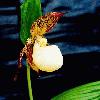 Cypripedium kentuckiense
Cypripedium kentuckiense
Sabot du Kentucky Kentucky-Arkansas H: 80 cm (32 in) 3rd year plants Z: 7 Blooming: April-May This is the largest of the lady's slippers with a large cream-colored pouch and maroon sepals and petals. This is C. parviflorum`s southern cousin. Cypripedium species normally bloom after their 5th or 6th year (cycle) of growth. Mature plants have already bloomed or are of blooming size. This item has only a $6.50 Shipping & Handling Charge up to 25 plants ordered. This amount will be added to your order. They should flower within 1-2 years. plants will ship late April/Early May. |
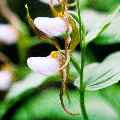 Cypripedium montanum
Cypripedium montanum
SOLD OUTNW North America H : 30-35 cm (12-14 in) Z : 3-5 3rd year plants Blooming: May - July A pretty stem, often multifloral, bearing delicate white slippers with long, dark, twisted petals. This is another relative of C. parviflorum, this one coming from mountainous regions. Cypripedium species normally bloom after their 5th or 6th year (cycle) of growth. Mature plants have already bloomed or are of blooming size. This item has only a $6.50 Shipping & Handling Charge up to 25 plants ordered. This amount will be added to your order. They should flower within 1-2 years. plants will ship late April/Early May. |
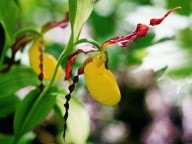 Yellow Lady Slipper
Yellow Lady Slipper
The American Indians called this plant "kwa-ko-ri-en ra-o-ta", meaning
mocassin. The rhizome is found in native pharmacology for its stimulating effect
on the nervous system. The flower is fragrant with a brilliant yellow pouch and
dark-brown, twisted petals. This item has only a $6.50 Shipping & Handling Charge up to 25 plants ordered. This amount will be added to your order. These are 5th year transplants. They should flower within 1-2 years. plants will ship late April/Early May. |
|
Ads by Google |



 1999 -
1999 -